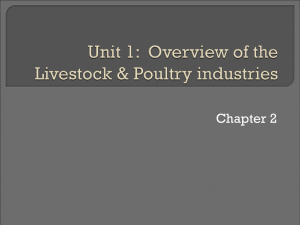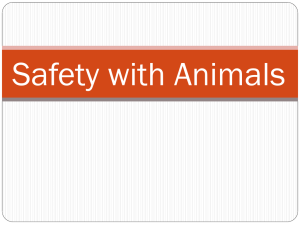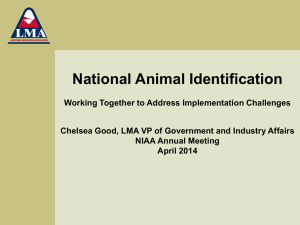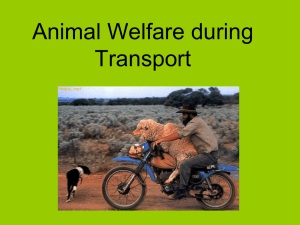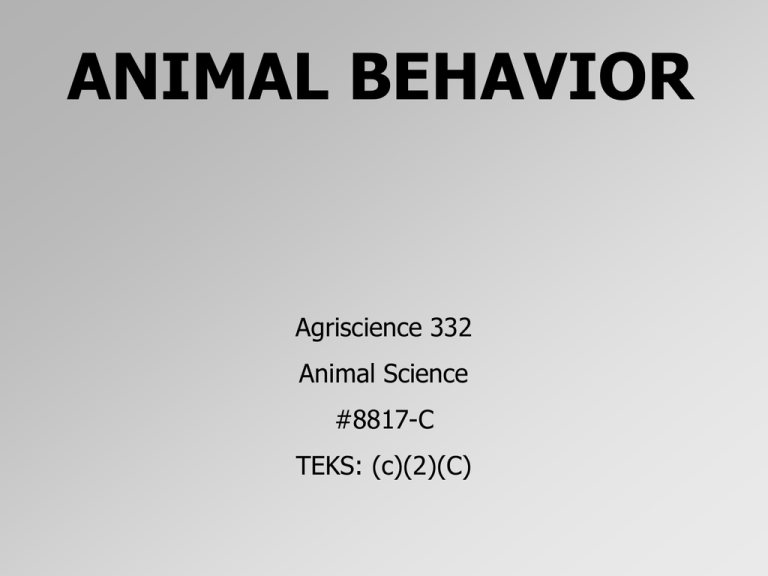
ANIMAL BEHAVIOR
Agriscience 332
Animal Science
#8817-C
TEKS: (c)(2)(C)
Introduction
The behavior represents the
interface between an animal and
its environment.
Behavioral responses are usually
the most flexible and are a rapid
way for the animal to promote
survival.
Ethology is the study of animal
behavior in the animal’s natural
habitat.
Livestock and poultry producers
need to be knowledgeable of
animal behavior patterns so they
can more effectively and efficiently
manage and train livestock.
Management of animal behavior
can influence the animal’s
economic production.
Factors Determining
Behavior
Personality or disposition differs
with each animal.
Genetics and environment are two
major factors that determine or
influence an animal’s disposition.
Genetics and instincts cannot be
altered, but producers can do
something about the environmental
situation.
Modifying the local environment to
cater to particular livestock or
poultry needs can improve animal
production.
Many animal behaviors are a result
of the interactions between the
genetics with which an animal is
born and its environment, which is
influenced by imprinting,
photoperiod, and social grouping.
Simple and complex behaviors
include:
• Instinct,
• Habituation,
• Conditioning,
• Reasoning,
• Intelligence, and
• Imprinting.
Instinct – unlearned behaviors
that an animal exhibits from time
of birth.
Instincts or reflexes seem to be
preprogrammed in the central
nervous system to respond to
specific stimuli in certain ways.
At birth, all mammals have the
instinct to nurse.
A mother has an instinct to care
for her young.
Photo by M. Jasek.
Habituation – gradual adaptive
responses to certain stimuli or to
the environment; “getting used to”
or ignoring certain stimuli.
Conditioning – a learned response
that is developed when an animal is
rewarded for making the proper
response to a stimuli.
Example: Cattle learn to come
when called (stimuli) at feeding
time because they are rewarded
with feed.
Reasoning – the animal’s ability to
respond correctly to a stimulus
when presented with a new
situation.
Intelligence – the animal’s ability
to learn to adjust successfully to
certain situations.
Imprinting – early-age learning
where young animals bond with
their mothers or parents and learn
to associate members of their own
species or even
with humans
and other
species.
Photo by Bruce Fritz courtesy of USDA Agricultural Research Service.
Imprinting is a critical period that
varies in length for different species.
Exposing animals to humans during
this time decreases stress on the
animals during their future contacts
with people.
Lambs should be first handled by
humans two days after birth.
For horses, the first 42 days of life
are most important for human
contact.
Extended contact over the first
nine months of life is the best time
to accustom cattle to humans.
Types of Behavior
Understanding animal behavior
helps a producer analyze the
results of animal nutrition,
physiology, breeding, and
management.
Comprehending behavior increases
the efficiency of labor, limits
handling problems, decreases
accidents to humans and other
animals, and increases the wellbeing and productivity of livestock.
The following behaviors are the most
influential to an animal’s welfare,
productivity, and profitability:
• Sexual,
• Shelter-seeking,
• Maternal,
• Investigative,
• Communication,
• Allelomimetic, and
• Social,
• Fear.
• Feeding,
Sexual Behavior – behavior in
animals related to courtship and
mating.
“Standing heat” or estrus is an
observable condition that helps
identify cows that are ready for
breeding.
Cows that are in heat exhibit
symptoms such as allowing
themselves to be mounted by other
cattle, trying to mount other cows,
acting nervously, seeking out the
bull, allowing chin-resting on her
rump, and raising the tail.
Isolated cows in estrus may be
restless, walk the fence, and bawl.
Producers use standing heat to
determine appropriate time for
artificial insemination.
The bull is attracted to a particular
cow in a herd by viewing cow-tocow mounting.
Bulls are also attracted to cows by
olfactory cues.
Pheromones in vaginal secretions
and in urine are detected by the
males through smell.
When a cow reaches full heat,
she allows a bull to mount.
Females are receptive for varying
lengths of time.
Cows are usually in heat for
approximately 16 hours, ewes and
nannies for 24 to 36 hours, and
mares for 5 to 7 days.
Ewes may show silent heat; that is,
they have no outward signs to
indicate that they are in heat.
A boar does not seem to detect a
sow that is in heat by smell or sight.
If a boar is introduced to a group
of sows, he will chase any sow,
whether she is in heat or not.
When courting the female, the
boar will nudge her in the flanks
or around the head and then
attempt to mount.
A sow that is in heat will seek out
the boar for mating.
The sow may show outward signs
of estrus, such as restlessness,
urinating frequently, attempting to
mount other sows, and loud
grunting.
Livestock tend to be polygamous;
that is, they breed freely without a
particular mate.
Poultry do exhibit preferential
mating.
Both male and female poultry may
refuse to mate with certain females
and males, respectively.
The sex of an animal relates to
behavioral patterns.
Castration changes behavior.
Non-castrated, or intact, males are
more aggressive in behavior.
Castrated males are more docile.
Maternal Behavior – livestock
mothers exhibit behaviors that
provide care for babies at birth.
Photo by Christine Stetter
With cattle, sheep, goats, and
horses, the mothers lick their
young to clean them off.
This licking stimulates blood
circulation and encourages the
young to stand and nurse.
A sow does not lick her young, but
does lie down and move her feet to
encourage her young to nurse.
Cows, sows, and mares normally
become very aggressive in
protecting their young.
The ewe and lamb, as well as, the
cow and calf have particularly
strong attachments.
When beef cows and ewes
decrease their milk production,
care giving declines to force the
young to search for forage.
This occurs approximately 100-120
days after birth with cows and 6075 days after birth with ewes.
Communication Behavior – any
of the senses can be used for
communication.
Smell helps a mother identify her
offspring.
Distress calls are used by young
when separated from their mothers
and by adults when under stress.
Farms animals respond to calls or
whistles used by the producer
when it is feeding time.
The animals learn that the sound
(stimulus) relates to being fed
(reward).
Social Behavior – livestock
exhibit social behavior when they
are in physical contact with other
animals or when humans are
present.
These behaviors can be aggressive
or passive.
Interaction with other animals:
Male farm animals fight when they
meet other unfamiliar males of the
same species, unless they are
castrated.
Females fight less than males, but
they generally develop a social
ranking, or pecking order.
Social ranks normally exist in herds
of cows, goats, sheep, and horses,
as well as, in flocks of poultry.
Factors affecting social rank include:
• age,
• size,
• strength,
• genetic background, and
• previous experience.
Horned cows usually outrank
polled or dehorned cows, especially
when space is limited.
Interactions with humans:
An animal’s response to human
interaction or handling determines
the animal’s disposition, which can
range from docile to wild.
Disposition is a result of inherited
characteristics, as well as, previous
human treatment of the animal.
Producers should treat animals
with care to promote a positive
disposition.
Animals with extremely wild
disposition should be culled from
the herd.
Animals with wild dispositions are
a threat to personal safety, may
damage facilities, and can
excite/injure other animals.
Nervous, excitable cattle have
lower weight gains and greater
incidence of dark cutters and
tough meat than do calmer cattle.
A person should know an animal’s
disposition before making initial
contact with the animal.
Behavior during handling and
restraint:
Knowledge of animal behavior is
important for safety and for
decreasing the stress on both the
producer and the animal.
The ease of handling animals
depends on the disposition and
size of the animal, previous
experience with the animal, and
design of the handling facilities.
Most animals have a flight zone, or
personal space.
When another animal or a person
moves inside this zone, the animal
normally moves away.
An animal also has a point of
balance, which is the shoulder.
An animal moves forward, if a
handler stands behind the point of
the shoulder and moves backward,
if a handler is in front of the point
of balance.
Cattle have orbital vision (their field
of view ranges from 310º to 360º),
making them sensitive to shadows
and abrupt movements.
Cattle also have blind spots directly
in front and behind and may charge
or kick, if approached from the front
or rear.
Curved chutes with solid sides are
appropriate for cattle.
When working with cattle, a
producer should eliminate strange
odors and noises (especially highpitched noises) and refrain from
waving the arms and hands.
Cattle and horses do not like to
enter darkened areas.
That is why it is important to open
a window or door on a trailer when
loading an animal.
Livestock follow the leader in a
single file in a partially empty
chute and they will move forward
to fill in a vacant space.
Feeding Behavior – feed
preferences and length of grazing
and rumination are behaviors
related feeding.
Sheep and goats graze 9 to 11
hours per day, while cattle graze 4
to 9 hours per day.
Animals will graze more heavily
near a water source.
Age of animal and weather
conditions affect grazing behavior.
Animals usually eat less during
extremely hot or cold
temperatures.
Following grazing, ruminants will
rest and ruminate (chew cud).
Sheep ruminate 7 to 10 hours per
day; cattle ruminate 4 to 9 hours
per day.
Animals develop feed preferences
by identifying nutritious feeds and
avoiding toxic materials.
This behavior is learned by young
from being around their mothers
or other animals.
Young animals will try new feeds.
Shelter-Seeking Behavior –
animals vary in the behaviors they
exhibit during hot and cold weather.
Hogs try to find a wet area when it is
hot.
Sheep and cattle prefer shady
areas for rest and rumination when
it is hot and tend to crowd together
during cold weather.
Investigative Behavior – animals
tend to be curious, but cautious,
when approaching humans or
investigating strange objects.
Horses, dairy goats, pigs, and cattle
tend to be more curious investigators.
Sheep are generally more timid and
less curious.
Allelomimetic Behavior –
behavior in which animals tend to do
the same thing at the same time.
Ruminants normally graze, rest, and
ruminate together at the same time.
Cattle grazing on large range areas
tend to gather together at the
watering place at the same time of
day.
This behavior helps the producer
monitor all the animals at one time,
which is especially useful in
detecting females in heat for
artificial breeding systems.
Fear Mechanisms – fear is a
survival emotion that motivates
animals to flee from danger.
Livestock may develop permanent
fear memories.
Fear memory problems usually occur
in flighty, excitable horses and cattle.
By making new experiences for
animals pleasant, producers can
handle animals in a calm manner at
a later time.
Abnormal Behavior
Knowledge of normal behavior of
livestock allows an observant
producer to detect abnormalities.
Abnormal behavior can be used to
identify clues to illness, stress,
inadequate nutrition, and other
problems.
Stress and sickness are two of the
main causes of inappropriate or
unusual behavior.
Stress is any environmental factor
that can cause major changes in the
animal’s physiological processes,
including:
• low or high temperatures;
• nutritional deficiencies;
• dust;
• fatigue;
• weaning;
• transportation;
• dehorning;
• docking;
• castration;
• abusive or excessive handling;
• social aggression; and
• overcrowded living conditions.
When handling livestock, producers
can reduce stress by creating social
identification with the animals
through routine physical contact
with the animal (stroking,
scratching, and patting) and use of
voice or gestures.
Prolonged stress is detrimental to the
body’s immune system and reduces
resistance to diseases.
Identifying sick animals and isolating
them from healthy animals allows the
producer to treat animals in early
stages of sickness, when they are
more likely to recover, and prevent
more animals from getting sick.
Symptoms of a sick animal include:
• Loss of appetite;
• Restlessness and depression;
• Ears droop or not in an alert
position;
• Humped back with a lowered head;
• Isolation (stays away from the
herd);
• Coughing, wheezing, or labored
breathing; and
• Vital signs differ from normal
ranges.
Normal Vital Signs of
Livestock
Producers should know the normal
vital signs of their livestock.
Drastic extremes from the normal
ranges are serious threats to an
animal’s health.
Normal Vital Signs
Vital
Sign
Cattle
Chicken
Horse
Sheep
Swine
Rectal
temp. (ºF)
Avg. &
Range
100.5
100.4-102.8
107.1
105.0-109.4
100.0
99.1-100.8
102.3
100.9-103.8
102.5
101.6-103.6
Avg.
respiration
rate per
minute
30
12-36
12
19
16
Avg. heart
rate per
minute
50
275
45
75
60
Body temperature – an elevated
body temperature can be caused
by infectious diseases, as well as,
excitement, exercise, digestion,
rest, and high environmental
temperatures.
A more serious situation is a sick
animal with a body temperature
below the normal range.
Respiration Rate – the respiration
rate of an animal varies with
excitement, exertion, and size of
the animal.
An increased respiration rate is a
concern if it is due to fever, pain,
weakness, infection, or lung
ailment.
Pulse (Heart) Rate – the size and age
of an animal influences their pulse
rate, as does exercise, excitement,
digestion, and elevated body
temperature.
Younger animals tend to have more
rapid pulse rates.
Smaller animals tend to have more
rapid pulse rates.
Summary
Knowledge of animal behavior will
help producers to be more efficient
in managing livestock enterprises
which will be safer and more
productive.
ALL RIGHTS RESERVED
Reproduction or redistribution of all, or
part, of this presentation without
written permission is prohibited.
Instructional Materials Service
Texas A&M University
2588 TAMUS
College Station, Texas 77843-2588
http://www-ims.tamu.edu
2007



